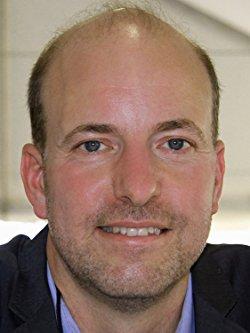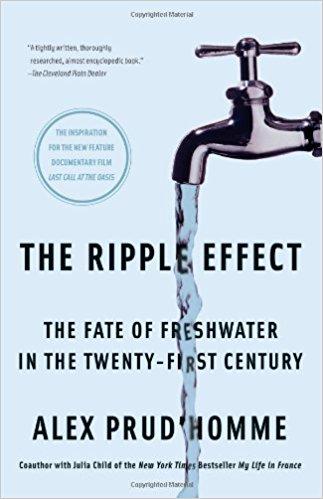The Ripple Effect Summary
<1 min read ⌚
 The Fate of Freshwater in the Twenty-First Century
The Fate of Freshwater in the Twenty-First Century
We notice the scarcity of a resource when it is already too late.
Similarly, we underestimate natural resources because we have them in abundance. Or at least we think that they will never disappear.
But the reality is much more different than that.
Read our summary of “The Ripple Effect” and recognize the problems humanity has with freshwater.
Who Should Read “The Ripple Effect”? And Why?
In places where you can get freshwater by merely turning on the tap, people do not realize that water, too, is a resource that can disappear.
Alex Prud’homme says just that – that the days of reliable access to water are in danger.
We recommend “The Ripple Effect” to future-focused engineers, urban planners, visionaries, green-minded industrialists and all other readers who want to understand why plastic bottles of water are not an answer to the freshwater problem.
About Alex Prud’homme
 Alex Prud’homme has written a memoir of his aunt, Julia Child, titled “My Life in France,” and publishes with The New Yorker, Time and Vanity Fair.
Alex Prud’homme has written a memoir of his aunt, Julia Child, titled “My Life in France,” and publishes with The New Yorker, Time and Vanity Fair.
“The Ripple Effect Summary”
Climate change changed people’s understanding of the world.
Until it happened, people believed that the planet, and all it offers, are here for good.
However, it seems that the planet can change as well. So what would stop the life we know from changing?
Thoughts which were similar to these made people concerned about water.
Since the Clean Water Act of 1972, terrible things have happened to the abundance and quality of the water supply in the United States.
However, what threatens water that much?
You can look for the answer in industrial pollution. Take the Greenpoint neighborhood of Brooklyn, New York – it is just one of the examples of a lack of regulation and poorly comprehended environmental impacts.
Or, Newtown Creek, which became a lifeless stream soaked with chemicals, that most probably causes various types of rare cancers, all because of an oil-and-chemical spill.
An even more severe issue is industrial farming.
Industrial farms are the US’s most significant source of water pollution.
The U.S. controls concentrated animal feeding operations loosely, and E.coli, nitrogen, and phosphorus keep being added to the waterways.
However, even though the world is conscious of these problems, the types and number of chemicals entering US waters are increasing.
Altering the situation will not be an easy thing to do.
On the bright side, glimpses of hope still exist.
In Orange County, California, a wastewater-purification plant supplies part of the water needs of over two million people, trying to address the water scarcity problems.
Recycling becomes something that people need to work on actively.
Big cities usually tried to solve their water scarcity problems by building massive pipes, through which they import water from more water-rich places.
However, cities in America have problems which are just a fraction of what people in other parts of the world experience, like for example the citizens of Perth, Australia.
The water scarcity problems there are so severe, that people are considering moving away because of the never-ending drought.
Some politicians believe that more dams will satisfy the demand for freshwater. However, critics think that the answer lies in an entirely another place: in society’s advancement.
In other words, for a real change, using advancing technologies that waste less water, and changing people’s mindset is essential.
Furthermore, climate change does nothing to help the problem – it just worsens it.
It is expected that climate change causes to momentary oversupplies or water. Sea levels will rise, the likeliness of hurricanes will increase and so on.
Many places will experience floods since they lack a sound preventative infrastructure.
The engineers that are responsible for flood control act too late – after disasters happen.
The infrastructural problems should be addressed in order to prevent disasters, not to minimize the strength of their hit. Using the solutions beforehand is much cheaper and easier.
Key Lessons from “The Ripple Effect”
1. Engineering the Future
2. Big Solutions
3. The Need for Stronger Politics
Engineering the Future
Farmers keep using the old ways of working and believe that the less water-intensive irrigation methods are unrealistic.
Farming is the most substantial water-consumer in the world, with energy coming second.
Power generation plants need water for cooling down. Hydrofracking is highly water intensive as well and generates pollution on top of it.
It is clear that something needs to change.
Big Solutions
As people are getting more aware that water is a resource that can be spent and the world can face water shortage, they are putting in more efforts to find permanent water sources.
One of those solutions is cloud seeding, a chemical process which induces rain. Next, there is the desalination technology, which utilizes reverse osmosis.
The Need for Stronger Politics
A stronger politics needs to be implemented, not just for imposing more regulation, but to also teach people why investing in water is so significant, and how precious water actually is.
Like this summary? We’d Like to invite you to download our free 12 min app, for more amazing summaries and audiobooks.
Our Critical Review
Alex Prud’homme believes that the days of reliable natural resources are in danger and are nearing their end.
In his book “The Ripple Effect” he spares no one and lists all the unpleasantries regarding pollution, growing population, increasing scarcity and taking control of public resource for material interests only.
At the very core of this book, there are numerous portraits of real people, and, by creating that personal touch in his writing, Prud’homme gives readers hope, that somehow these problems are solvable.
Ultimately, they were created by humans and there is no reason not to believe that they can be solved by humans as well.
Emir is the Head of Marketing at 12min. In his spare time, he loves to meditate and play soccer.


 The Fate of Freshwater in the Twenty-First Century
The Fate of Freshwater in the Twenty-First Century




